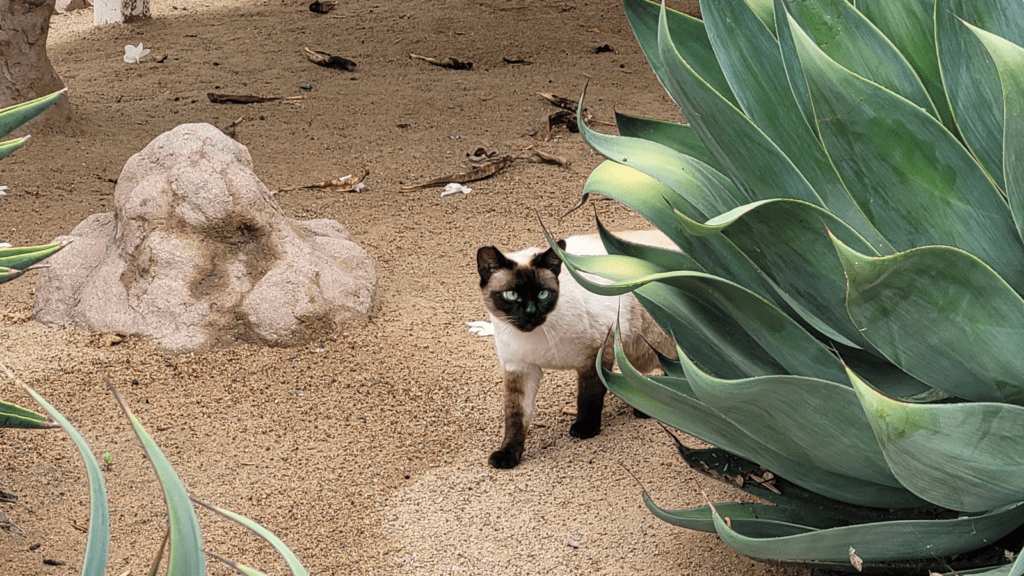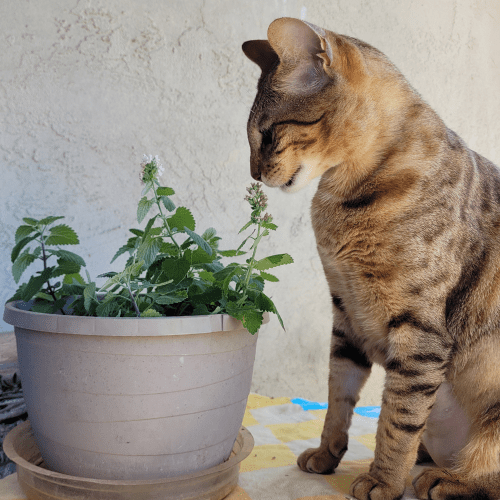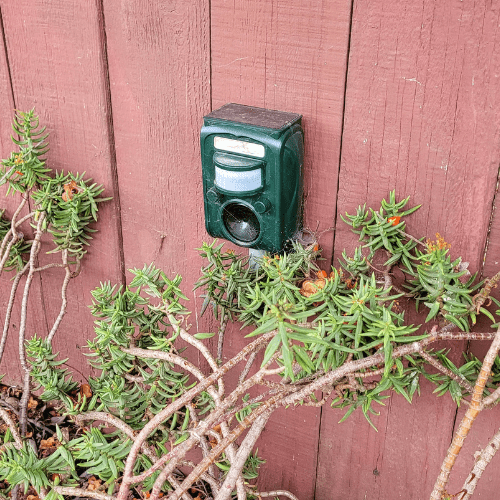
Best Cat Repellent And Deterrents
No one wants to scoop poop from someone else’s pet! Even pet owners who love cats might be looking for humane ways to keep outdoor cats out of their yards.
Cats are sensitive creatures, so repelling them can be quite simple. Lavender planted around the garden, citrus peels cut into fine slices, and motion-detecting sprinklers are just a few options. It’s also a good idea to cover any dirt with rocks, chicken wire, or other objects to make it a less appealing place for cats to use as a litter box.
In this article, we’ll discuss what attracts cats to the garden and the best cat repellent and deterrents to keep cats out of your yard for good!
What Attracts Cats?
Before you work to repel cats from your garden, let’s look at the things that might be attracting them. The first step is to remove temptations so that cats don’t have a reason to be in your yard in the first place.
Cats are typically going to come into your yard for one of four reasons: food, shelter, a place to go potty, or because of other cats.
Since you’re likely not feeding cats, we can mostly rule that out—but ensure your trash is secured so the cats don’t rummage through.
Next, the cats might be looking for a place to hide. Cats spend the majority of their days hiding and sleeping. This could be under a deck, behind trash cans, in the bushes, or even under your car.
Use runners to block off the space beneath your deck, park your car in the garage, and remove or block off access to other hiding spots as best you can. Additionally, you can add rough surfaces beneath the hiding space to make it less comfortable.
Next, outdoor cats have to do their business somewhere! They’re most likely to attempt in easy-to-bury locations. Exposed dirt acts as a natural litterbox, while cats will be less likely to go in planters covered by rocks, for example.
Lastly, there could be other cats or animal scents attracting them. My neighborhood cats like to tease my indoor cats sitting in the window. The outdoor cats will often times mark our front door as a result.
Best Cat Repellents
Cat Repellent Plants
Cats’ noses are sensitive. Like dogs, they can smell things we cannot. The scents that are strong to us can be unbearable for them and work as an effective cat repellent.
We can use this to our advantage when keeping cats out of the garden. Here are just a few cat-repellent plants that cats hate:
- Lavender
- Rue
- Geranium
- Eucalyptus
- Lemongrass
- Rosemary
Plant these scattered throughout the garden or in the location you want cats to discourage cats from. It’s very likely to deter them!

Rough Surfaces
Cats are creatures of comfort, and they don’t like the feeling of rough surfaces beneath their feet. Plastic carpet runners are a great way to keep cats from the garden. Leave them pointy-side up, and the cats are sure to turn away after stepping one foot onto them! A plastic carpet is good for indoor and outdoor use to train the cat’s behavior.
You can also use chicken wire or anything else with a gridded style to prevent digging. The mesh will be uncomfortable while not hurting the kitties’ feet. This is also a good option to lay under the top layer of your flower beds.
Another option is to scatter natural materials like pinecones, rocks, and sticks around the garden to make the ground rough and unpleasant. These natural ingredients also make for some beautiful landscaping if you get creative with it!
Food Scent Repellents
Cats hate scents like citrus, cinnamon, bitter apple spray, and peppermint, which are non-toxic and completely safe for cats. Scattering some orange peels in the garden or topping your soil with ground cinnamon can be enough to keep cats out.
These foods are also good for your plants once they break down, providing nutrients to the soil—though this does take time, particularly if the foods are in large pieces, as with citrus peels.
Cat Repellent Sprays
Never spray a cat directly with repellents, and never use harsh chemicals or sprays that aren’t approved for cat use. Cat sprays contain strong smells that cats find unpleasant, such as citronella, peppermint, and garlic. Sentry Stop creates a line of natural cat repellent sprays that you can use on your entire yard.
Spraying these solutions around the perimeter of your yard or garden is an effective way to deter cats from entering. The key is to reapply the cat spray regularly so that it remains potent. A good cat repellent spray with a strong smell can last up to two months and keep your yard free of most cats.
Sprinklers
We all know that cats hate water, but there’s no way you can sit outside with a spray bottle or hose around the clock to keep the cats away. They’re primarily active at night, and besides, your neighbors would likely judge!
Instead, install motion-activated sprinklers around the garden. These will turn on when the cats approach, and the consistency will keep them away. Sprinklers can be a very effective cat deterrent!
Ultrasonic Sound Cat Deterrents
Ultrasonic deterrent devices will emit a sound that repels cats, but human ears can’t hear. They’re motion-activated and best used at the entrance of your yard or garden or in the places where cats hang out the most since they cover small areas.
Be careful if you have your own pets at home, as this noise might also bother them. Wildlife may also be affected.

Motion Lights
Motion-activated lights can scare away skittish cats, particularly if they’re feral and avoid interacting with humans. These can be scattered throughout the garden or put in the kitty’s favorite spots to deter them from coming around.
Dummies and Scarecrows
Dummies and scarecrows can also be placed on fencing or elsewhere in the yard to scare cats away. There are dummies made to look like birds of prey that could prove particularly useful.
Create Cat-Friendly Areas (away from your garden bed)
If you don’t mind cats in your yard but want to protect your garden bed, consider providing shelters, litter boxes, and feeding areas away from your yard to lure them from your garden. Having cat-friendly outdoor spaces can be rewarding for you and your family—kids will love seeing and petting the friendly outdoor cats.
Cats also love plants like catnip, spider plants, and silver vine, and the cats will be much more likely to use the new space.
Cat Repellents To Avoid
Commercial Or Non-Natural Chemicals
Chemicals in your garden can harm cats rather than simply deterring them. They can also harm your garden, especially if you’re growing food.
Your family, including your children and pets, can also be harmed by chemicals used to deter cats. They’re also bad for the environment and wildlife.
For instance, many people will suggest moth balls in the garden, but these are extremely harmful to place outdoors.
Aggressive Dogs
You can’t wholly control whether or not your dog attacks a cat, especially if the cat is wandering through your fenced yard. However, dog owners should never intentionally allow their dogs to attack a stray cat as a deterrent.
Remember that humans are the reason for outdoor cats—it’s not the cats’ fault they’re here, so although they can be pesky and bad for the environment, hurting them is not the answer.
The current method of controlling cat populations is TNR (trap, neuter, return).
Shooting Or Hurting The Cats
Not only is shooting or otherwise hurting cats inhumane, but it’s also illegal. You can be charged with animal cruelty and sued by your neighbors for hurting their pets.
The severity of the crime depends on the laws in your state, but all 50 states have animal cruelty laws on the books.
Inhumane Traps
You might even consider trapping the cat and taking them to a humane society. If you need to trap a cat, use a humane live trap and give the cat to someone who will care for it, such as a cat rescue or someone who will provide them with an indoor home. Never use traps meant to kill or injure cats.
Relocating The Cat
Relocating cats isn’t recommended because they have a homing instinct and are likely to wander back to their territory eventually. They can also be hurt along the way if they travel through traffic or other dangerous areas.
The euthanasia rate for feral and stray cats in shelters can be high. Rather than going to a shelter, contact a local TNR program (Trap, Neuter, Return) and find an advocate who can help safely relocate and rehome the cat.
There are programs that rehome feral cats to be barn cats on farms or live in feral cat sanctuaries. Sanctuaries are experienced and keep the cats enclosed for a period of time to prevent them from wandering back to their original home.
However, the best place for a feral cat is usually right where they are. Use the above tips to keep them out of unwanted areas and learn to coexist with the felines in your neighborhood.
It’s very likely that if you removed the current community cats, new cats would encroach on the territory—so the current cats do serve a purpose, and it’s usually better to manage the colony rather than remove or relocate them.
Conclusion
The best cat repellent or cat deterrent is simply understanding and accepting the nature of feral or stray cats. They are usually not domesticated pets and may have different behaviors and needs than typical pet cats. You can use motion-sensor repellents to repel cats like an ultrasonic device, spray deterrent scents or an odorless spray, or place deterrent tape on their favorite scratching furniture. The most effective cat repellent doesn’t harm the cat but is great at deterring cats and other animals.



